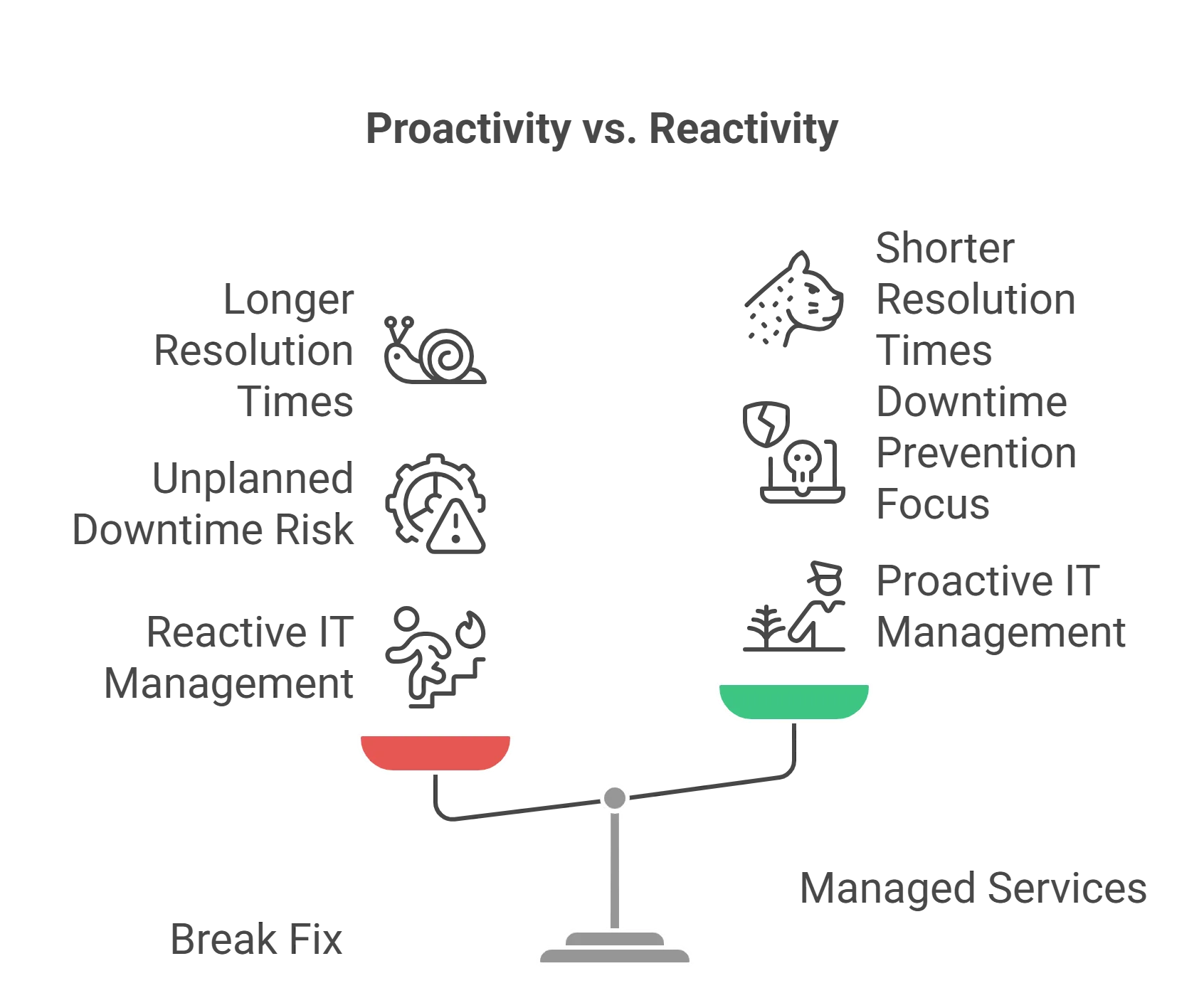Downtime can severely disrupt your business operations, leading to lost revenue, decreased productivity, and potential damage to your reputation.
If you’re still relying on break-fix services, you might not fully realize the risks and costs you’re incurring until it’s too late. Many businesses wait for something to go wrong before they act—but by then, the damage could already be done.
In fact, the average cost of downtime for small businesses is $427 per minute, a figure that can quickly add up if IT disruptions aren’t addressed proactively. With break-fix services, your response to problems is reactive, meaning you only pay when something goes wrong. This approach often leads to higher costs, extended downtime, and missed opportunities.
| As James Palmisano, President and CTO of Iserv, says, “Proactive IT management is essential in today’s competitive market. Businesses that use managed services gain an edge by staying ahead of issues before they impact operations.” |
In this blog, we’ll explore the break-fix vs. managed services debate, comparing what each model offers and which one best suits your business’s needs.
Break Fix or Managed Services? Let’s Break It Down
When it comes to IT support models, break-fix and managed services offer vastly different approaches. Understanding how each model works can help you make the best decision for your business. Let’s dive into both options and see what they entail.
What is Break-Fix?
Break-fix services are reactive. This means that an IT support provider addresses problems as they occur. When a system failure or technical issue arises, the business calls the IT provider to fix it. You only pay when something breaks, which may seem cost-effective at first glance.
However, this approach has its drawbacks. Since you only pay for services when there’s a problem, there’s little to no ongoing maintenance or monitoring of your systems. If an issue arises, it can result in downtime until it’s resolved, leading to productivity losses, missed opportunities, and potentially financial costs.
How Break Fix Works:
- You contact the service provider when something goes wrong.
- The IT professional arrives, diagnoses the issue, and resolves it.
- You pay based on the time and resources needed to resolve the issue.
This model is well-suited for businesses with minimal IT requirements or those that can tolerate the unpredictability and potential downtime.
What Are Managed Services?
Managed services are when a third-party company, known as a managed service provider (MSP), takes responsibility for managing and maintaining your IT infrastructure. Instead of waiting for issues to arise, the MSP continuously monitors and manages your systems, ensuring everything runs smoothly. They handle tasks such as security, software updates, backups, and troubleshooting, often preventing problems before they disrupt your business operations.
How Managed Services Work:
- A managed services provider monitors your IT systems 24/7.
- They perform regular maintenance tasks like software updates, patches, backups, and security scans.
- You pay a fixed monthly fee for ongoing IT support, which helps with budgeting.
This proactive model ensures reduced downtime and greater security, which can significantly boost your productivity and long-term business performance.
Stop Reacting, Start PlanningMove beyond break-fix with a smarter IT business strategy that prevents downtime before it starts. |
Key Differences Between Break-Fix vs. Managed Services
Understanding the primary differences between break-fix and managed services is crucial to choosing the right IT support model for your business. Here, we’ll explore five major criteria that set them apart:
1. Cost Structure: Predictable vs. Reactive
- Break Fix: In the break-fix model, your costs are reactive and unpredictable. You pay only when something goes wrong. This can lead to lower initial costs but higher overall expenses when problems arise unexpectedly. Each service call incurs an additional charge, which can be costly if issues occur frequently.
- Managed Services: With managed services, you pay a fixed monthly fee, regardless of how often you need support. This predictable cost structure makes budgeting easier and helps avoid surprise expenses. Over time, this can save you money by preventing costly emergencies and unplanned downtime.
2. Support Availability: On-Demand vs. Continuous
- Break Fix: Support is available only when something breaks. When you experience an issue, you call the provider, and they respond as quickly as they can. However, response times can vary depending on their schedule and availability, and you could face delays during busy periods.
- Managed Services: Managed services provide 24/7 support. MSPs continuously monitor your IT systems, ensuring potential issues are detected and addressed before they escalate. This round-the-clock availability ensures that any issue is addressed promptly, minimizing downtime and maintaining smooth business operations.
3. Proactivity vs. Reactivity
- Break Fix: The reactive nature of break-fix means that your IT infrastructure isn’t actively managed. Problems often go undetected until they cause disruption, leading to unplanned downtime. By the time you call for help, the issue could have worsened, leading to longer resolution times.
- Managed Services: Managed services are built around a proactive approach. MSPs constantly monitor your systems for performance issues, security threats, and other vulnerabilities. Regular maintenance tasks, such as software patches, updates, and backups, are performed on a routine basis to prevent problems from occurring. This proactive approach helps you avoid downtime and maintain smoother operations.

4. Scalability: Limited vs. Flexible Growth
- Break Fix: Break-fix services are less scalable. As your business grows and your IT needs become more complex, you may find it harder to manage with a reactive model. You’ll need to request support as new problems arise continually, and your costs will increase with every service call.
- Managed Services: One of the most significant advantages of managed services is their scalability. MSPs can easily adapt to your business’s changing needs. Whether you’re adding more users, expanding to new locations, or upgrading to more advanced technology, managed services can grow with you. This flexibility ensures your IT support is always aligned with your business’s trajectory.
5. Long-Term Strategy: None vs. IT Strategy Alignment
- Break-Fix: Break-fix services focus solely on resolving immediate technical issues. They do not offer a long-term strategic approach to your IT infrastructure. While your IT systems may be fixed when something goes wrong, there’s no overall strategy to optimize performance or align IT with your business goals.
- Managed Services: Managed services take a long-term, holistic approach. MSPs help develop an IT business strategy that aligns with your objectives. With 70% of businesses experiencing data loss due to issues such as accidental deletion, fire, or system failures, securing your data is crucial. MSPs offer insights on optimizing your IT, protecting your data, and streamlining processes to drive business growth, acting as a strategic partner for the future.
Break Fix vs. Managed Services: Key Differences
| Criteria | Break Fix Services | Managed Services |
| Approach | Reactive — issues are addressed after they occur | Proactive — continuous monitoring and prevention before problems arise |
| Cost Structure | Pay-per-incident or hourly billing; unpredictable expenses | Fixed monthly fee; predictable and budget-friendly |
| Downtime Risk | Higher problems are often discovered after causing disruption | Lower — early detection and maintenance help avoid downtime |
| Support Availability | Limited to business hours or service calls | 24/7 monitoring and support available |
| Scalability | Harder to scale; must react to each new issue | Easily scalable; services grow with your business needs |
| Strategic Value | Minimal — no long-term planning or insight | High — includes consulting on long-term IT business strategy |
| Security Coverage | Basic or inconsistent; depends on what’s broken | Strong focus on cybersecurity, backups, and compliance |
| More articles you might like: |

Make IT Support Work for Your Business
Choosing between break-fix and managed services isn’t just about cost — it’s about control, reliability, and long-term alignment with your business goals. If your current approach feels more like reacting to problems than preventing them, it may be time to rethink your IT strategy for business growth.
Many businesses find value in working with a partner who can offer both strategic guidance and hands-on support. That’s why companies turn to providers like Iserv — not just for technical fixes, but for helping shape a more innovative, more resilient business IT strategy that scales with them.
Contact us today to schedule a consultation and begin developing an IT strategy that aligns with your goals, not just your systems.
|
Discover Trusted Managed IT Services Near You |







